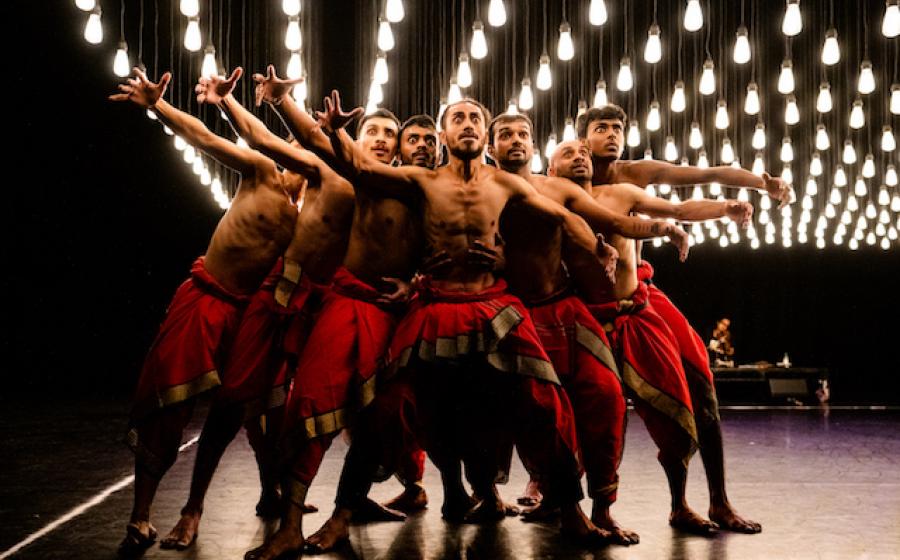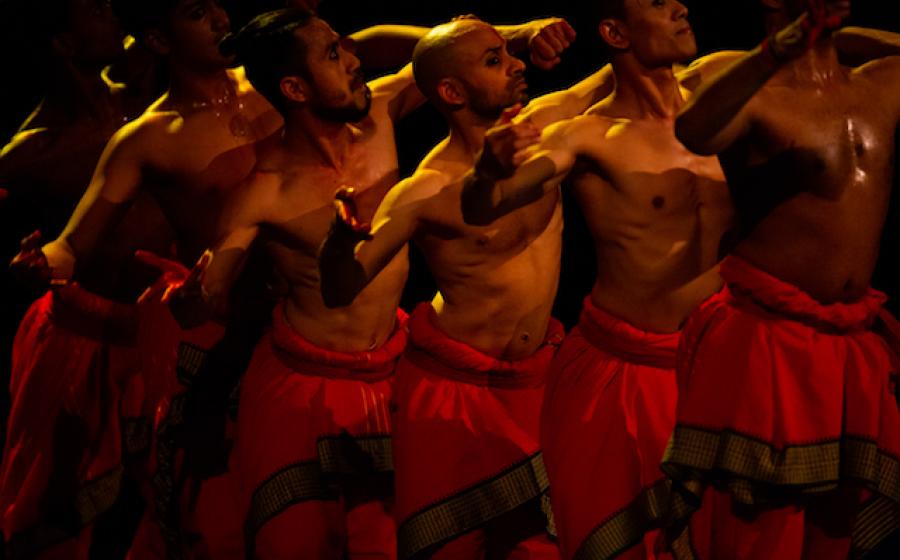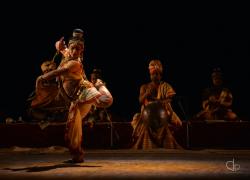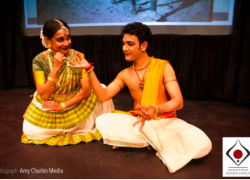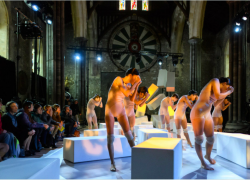Mavin Khoo and Temple of Fine Arts
Mavin Khoo and Temple of Fine Arts
Darbar Festival, Sadler’s Wells,
25th November 2019
Reviewed by Magdalen Gorringe
Photos by Rehmat Rayatt
Presented at the third Darbar festival based at Sadler’s Wells, this performance brought twelve fantastically accomplished artists to the stage: eight athletic male bharatanatyam dancers from the Temple of Fine Arts in Malaysia, bodies oozing with energy and command; and four tremendous female musicians, including that rare entity, the female mridangist (the one and only Rajna Swaminathan). As Akram Khan described in his introduction to the show, the choreographer, Mavin Khoo, has been involved with Darbar at Sadler’s from the outset. Having performed a solo work in 2017, explored a duet choreographed on two other dancers in 2018, this work on an ensemble of eight dancers is a logical progression.
To be able to watch eight professional dancers perform together is rare; to watch eight dancers of such calibre is exceptional. Quite simply, these dancers are phenomenal. The programme notes describe them as possessing a ‘hybridised Bharata Natyam form specific to the multi-layered body of the Malaysian dancers’, and certainly their form presents a true hybrid, not a forced fusion. The time and the labour (or sadhana) they have invested in committing their bodies to their dance form shows not so much through the rippling muscles of their torsos (though, let’s face it, these elicited more than an answering ripple from much of the
audience), but through their effortlessly deep aramandi, the spring and yet precision of their jumps, the bend and stretch of their bodies and arms that made even Sadler’s Wells main stage come close to seeming restrictive. Whether they have trained additionally in a form of martial arts, or whether they have disciplined their bodies so fully that they are able to call forth these movements when required, they performed the barrel turns, the leaps and kicks of the choreography in a manner that made the inclusion of these movements seem a natural extension of bharatanatyam, not a jarring import.

Khoo took the inspiration for this work from the well know story of the Ramayana, but explored though an often neglected perspective – that of Ravana, the complex anti-hero. The canon of Sanskrit and Tamil literature presents different sides of Ravana – he is a ten headed demon and yet one of Shiva’s most ardent devotees; he is the abductor of Sita, yet, as such, the loyal brother of Surpanakha; he pursues magic and enchantment, and yet is a respected ruler. These complexities, and the high action drama of the Ramayana itself give Khoo ample scope to display the diverse talents of the dancers. Adavus performed with vertical spines and crisp control give way to the crouch and caper of Hanuman, performed first as a compelling solo, then picked up by the other dancers to conjure the untamed strength and enthusiasm of the monkey army. Bharatanatyam meets acrobatics as the dancers deftly weave round each other presenting heads and backs to form the bridge across which Rama makes his way to Lanka. Two dancers circle each other warily and are subsumed in the onslaught of arrows suggesting the relentlessness of war. As part of this, the marching of the carmine clad dancers felt (perhaps deliberately?) a bit too close to reality for comfort. The contradictions of Ravana are brought out through an abhinaya solo portraying a certain vulnerability, contrasting with a Ravana portrayed by the eight dancers clumped together, arms wrapped round each other, backs bent, conveying the threat and bestiality of a giant spider.
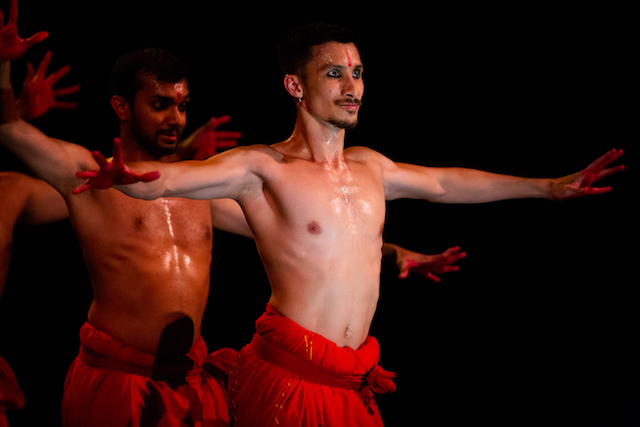
Throughout the performance the dancers are metaphorically lifted and supported by the compelling music of vocalist Chitra Poornima Sathish, violinist Pangasaasani Gowrisan, nattuvangist Lakshmi Krishnan and and mridangist Rajna Swaminathan (in music arrangedby Jyotsna Nithyanandan, Sathish and Khoo himself). Every so often the dancers add to the soundscape with a visceral roar, reminding us that Ravana is literally ‘the Roarer’ (from the Sanskrit root ‘ru’, to howl, roar or bellow).
Given the virtuosity of these dancers, and the difference they make by their presence to redefining our perceptions of and expectations from bharatanatyam it seems incredible that this was their first performance in the U.K. Where this piece may not have offered scope for it, I found myself missing some of the kaleidoscopic spread of jathis dissecting the space that Khoo brought to us in Images in Varnam (2001), and the beguiling intimacy with the character of each dancer that he brought out in Home (2017) choreographed on the ZfinMalta Dance Ensemble. For this reason, and so that their aptitude and audacity may continue to inspire us, I hope this performance represents not an end, but a beginning.

